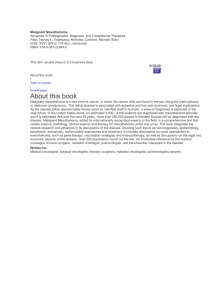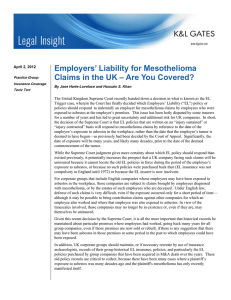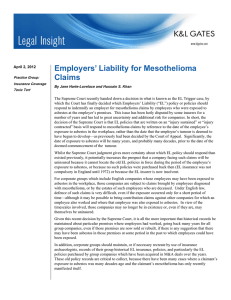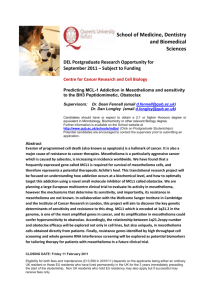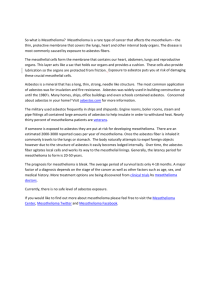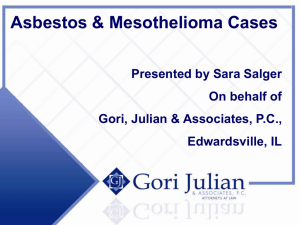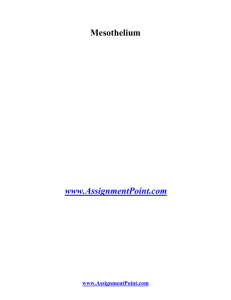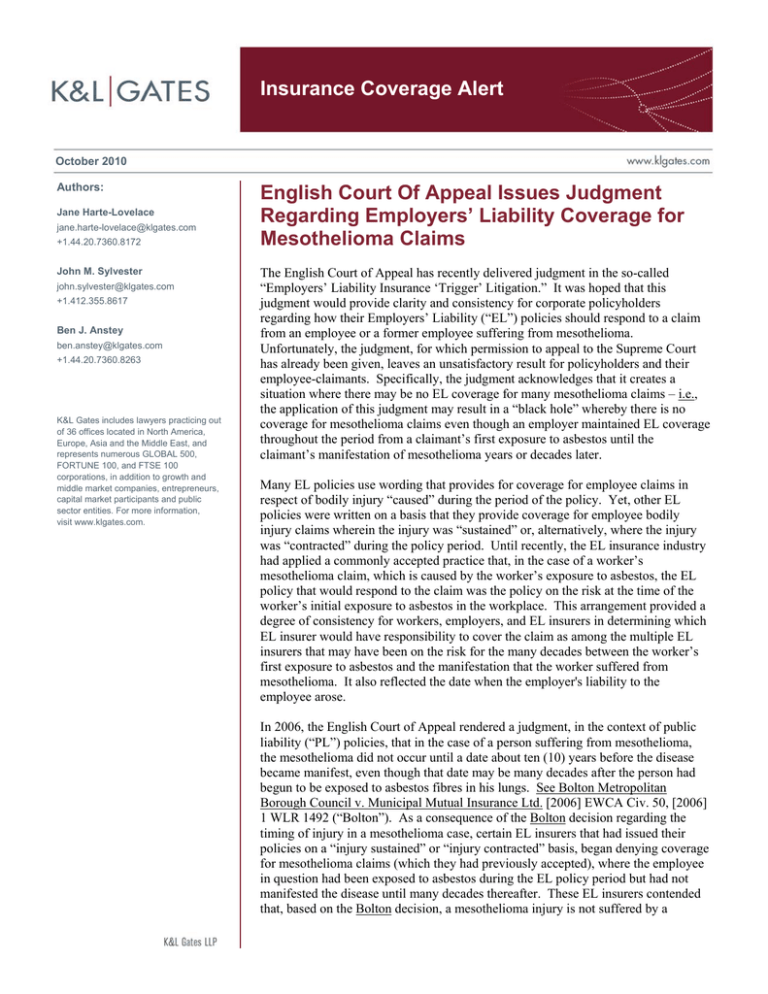
Insurance Coverage Alert
October 2010
Authors:
Jane Harte-Lovelace
jane.harte-lovelace@klgates.com
+1.44.20.7360.8172
John M. Sylvester
john.sylvester@klgates.com
+1.412.355.8617
Ben J. Anstey
ben.anstey@klgates.com
+1.44.20.7360.8263
K&L Gates includes lawyers practicing out
of 36 offices located in North America,
Europe, Asia and the Middle East, and
represents numerous GLOBAL 500,
FORTUNE 100, and FTSE 100
corporations, in addition to growth and
middle market companies, entrepreneurs,
capital market participants and public
sector entities. For more information,
visit www.klgates.com.
English Court Of Appeal Issues Judgment
Regarding Employers’ Liability Coverage for
Mesothelioma Claims
The English Court of Appeal has recently delivered judgment in the so-called
“Employers’ Liability Insurance ‘Trigger’ Litigation.” It was hoped that this
judgment would provide clarity and consistency for corporate policyholders
regarding how their Employers’ Liability (“EL”) policies should respond to a claim
from an employee or a former employee suffering from mesothelioma.
Unfortunately, the judgment, for which permission to appeal to the Supreme Court
has already been given, leaves an unsatisfactory result for policyholders and their
employee-claimants. Specifically, the judgment acknowledges that it creates a
situation where there may be no EL coverage for many mesothelioma claims – i.e.,
the application of this judgment may result in a “black hole” whereby there is no
coverage for mesothelioma claims even though an employer maintained EL coverage
throughout the period from a claimant’s first exposure to asbestos until the
claimant’s manifestation of mesothelioma years or decades later.
Many EL policies use wording that provides for coverage for employee claims in
respect of bodily injury “caused” during the period of the policy. Yet, other EL
policies were written on a basis that they provide coverage for employee bodily
injury claims wherein the injury was “sustained” or, alternatively, where the injury
was “contracted” during the policy period. Until recently, the EL insurance industry
had applied a commonly accepted practice that, in the case of a worker’s
mesothelioma claim, which is caused by the worker’s exposure to asbestos, the EL
policy that would respond to the claim was the policy on the risk at the time of the
worker’s initial exposure to asbestos in the workplace. This arrangement provided a
degree of consistency for workers, employers, and EL insurers in determining which
EL insurer would have responsibility to cover the claim as among the multiple EL
insurers that may have been on the risk for the many decades between the worker’s
first exposure to asbestos and the manifestation that the worker suffered from
mesothelioma. It also reflected the date when the employer's liability to the
employee arose.
In 2006, the English Court of Appeal rendered a judgment, in the context of public
liability (“PL”) policies, that in the case of a person suffering from mesothelioma,
the mesothelioma did not occur until a date about ten (10) years before the disease
became manifest, even though that date may be many decades after the person had
begun to be exposed to asbestos fibres in his lungs. See Bolton Metropolitan
Borough Council v. Municipal Mutual Insurance Ltd. [2006] EWCA Civ. 50, [2006]
1 WLR 1492 (“Bolton”). As a consequence of the Bolton decision regarding the
timing of injury in a mesothelioma case, certain EL insurers that had issued their
policies on a “injury sustained” or “injury contracted” basis, began denying coverage
for mesothelioma claims (which they had previously accepted), where the employee
in question had been exposed to asbestos during the EL policy period but had not
manifested the disease until many decades thereafter. These EL insurers contended
that, based on the Bolton decision, a mesothelioma injury is not suffered by a
Insurance Coverage Alert
claimant, in the form of a malignant tumor, until no
more than ten years before the disease is manifested.
Thus, they contended, no injury had been
“sustained” or “contracted” at the time of the
claimant’s exposure to asbestos in the workplace
while their EL policy was in force. This new
position by EL insurers that their policies written on
an “injury sustained” or “injury contracted” basis
would not provide coverage for mesothelioma
claims was challenged in the courts by corporate
policyholders and others. These court proceedings
came to be known as the “Employers’ Liability
Insurance ‘Trigger’ Litigation.”
In the first instance, the High Court (per Burton, J)
found that, with respect to mesothelioma claims,
there was no injury at the time of worker’s exposure
to asbestos. Rather, injury was suffered by the
worker about five years prior to the disease being
manifest. The High Court, however, also found that
mesothelioma was “caused” at the time of a
worker’s exposure to asbestos. Moreover, the High
Court ruled that an EL policy providing that its
coverage was triggered when an employee’s injury
was “sustained” or “contracted” would operate like
an EL policy that stated it was triggered when injury
was “caused,” and thus mesothelioma claims would
be covered by the EL policies on the risk when a
worker was exposed to asbestos in the workplace.
This ruling by the High Court was consistent with
the standard practice in the insurance industry that
EL insurance policies on the risk when a claimant
was exposed to asbestos would provide coverage.
The recent Court of Appeal decision (per Rix, Lord
Justice), however, has reversed in part the decision
of the High Court. The Court of Appeal has now
held that, where an EL policy contains “injury
sustained” wording, that policy will not respond if it
was in force when a worker was exposed to
asbestos, and the worker is diagnosed with
mesothelioma many years later. Rather, the worker
must look to the EL policy in place on a date five (5)
years before the diagnosis, because (on the basis of
current medical knowledge) that is the date that
injury is “sustained”. This ruling, however, may
create a “black hole” in coverage because, at the
date five years prior to diagnosis – which is likely
many years after his exposure in the workplace, the
claimants may well no longer be employed by the
same employer – or may not be employed at all
because of retirement -- and thus may not be
covered by any EL policy. Also, the claimant’s
former employer may no longer be in existence, and
thus may not have any EL coverage in place. There
may be other circumstances where the claimant may
be without recourse to any EL policy for his
mesothelioma claim given that coverage is not
triggered until many decades after the exposure in
the workplace that gives rise to the mesothelioma.
The Court of Appeal based its judgment on: (1) a
belief that it was bound to follow the finding in
Bolton that no injury was suffered by a
mesothelioma claimant at the time of exposure to
asbestos in the workplace; and (2) the phrase injury
“sustained” in an EL policy meant when injury was
suffered, not when injury was “caused.” However,
the Court of Appeal agreed with the High Court that
the phrase “injury contracted” in an EL policy
meant “injury caused”. It should be noted that Lord
Justice Rix, who gave the leading judgment,
expressed a personal view that would prefer to
depart from Bolton and find that injury develops in
a mesothelioma claimant at the time of exposure in
the workplace – and not many decades later – but
that he felt compelled to follow the Bolton
precedent.
The result of the Court of Appeal's judgment is that,
where EL policy wordings in force at the time of the
worker’s of exposure provide coverage on an
“injury sustained” basis, corporate policyholders,
despite maintaining decades of continuous EL
policies, may find that they have no EL coverage for
mesothelioma claims if the claimant was exposed
while working but later is diagnosed with
mesothelioma after leaving the employ of the
company. The Court of Appeal's judgment also
made clear that EL policies only cover current
employees, not former employees, and thus a retired
worker could not look to his former employer’s EL
policy at the time that his mesothelioma became
manifest.
This Court of Appeal judgment may have serious
consequences for companies that operated in past
decades where workers were exposed to asbestos at
its facilities and are now suffering from
mesothelioma. Those companies may be liable to
their former employees for compensation for the
mesothelioma claims, but may not have the
necessary EL insurance coverage unless their
October 2010
2
Insurance Coverage Alert
historical EL policies include the “injury caused”
language, rather than the “injury sustained” wording.
In addition, mesothelioma claimants whose former
employer, at the time of exposure, is now out of
business may find no recourse to the employer’s
historical EL insurers. These claimants may now
attempt to seek recourse against other companies
that are allegedly responsible for their exposure,
such as manufacturers of the products containing the
asbestos to which they were exposed. Such claims
could implicate those product manufacturers’ PL
insurance policies.
The last word on this issue has not yet been spoken,
as the Supreme Court will likely review the Court of
Appeal's judgment. Nonetheless, this judgment
makes it all the more important for a company to
gather and maintain records of historical EL and PL
insurance going back many decades, and to review
carefully their policy wordings to assess the
availability of coverage for asbestos-related claims.
This is especially true in the context of buying or
selling businesses that involved industrial
operations in the past, which operations may give
rise to asbestos claims in the future.
Anchorage Austin Beijing Berlin Boston Charlotte Chicago Dallas Dubai Fort Worth Frankfurt Harrisburg Hong Kong London
Los Angeles Miami Moscow Newark New York Orange County Palo Alto Paris Pittsburgh Portland Raleigh Research Triangle Park
San Diego San Francisco Seattle Shanghai Singapore Spokane/Coeur d’Alene Taipei Tokyo Warsaw
Washington, D.C.
K&L Gates includes lawyers practicing out of 36 offices located in North America, Europe, Asia and the Middle East, and represents numerous
GLOBAL 500, FORTUNE 100, and FTSE 100 corporations, in addition to growth and middle market companies, entrepreneurs, capital market
participants and public sector entities. For more information, visit www.klgates.com.
K&L Gates is comprised of multiple affiliated entities: a limited liability partnership with the full name K&L Gates LLP qualified in Delaware and
maintaining offices throughout the United States, in Berlin and Frankfurt, Germany, in Beijing (K&L Gates LLP Beijing Representative Office), in
Dubai, U.A.E., in Shanghai (K&L Gates LLP Shanghai Representative Office), in Tokyo, and in Singapore; a limited liability partnership (also named
K&L Gates LLP) incorporated in England and maintaining offices in London and Paris; a Taiwan general partnership (K&L Gates) maintaining an
office in Taipei; a Hong Kong general partnership (K&L Gates, Solicitors) maintaining an office in Hong Kong; a Polish limited partnership (K&L
Gates Jamka sp. k.) maintaining an office in Warsaw; and a Delaware limited liability company (K&L Gates Holdings, LLC) maintaining an office in
Moscow. K&L Gates maintains appropriate registrations in the jurisdictions in which its offices are located. A list of the partners or members in each
entity is available for inspection at any K&L Gates office.
This publication is for informational purposes and does not contain or convey legal advice. The information herein should not be used or relied upon
in regard to any particular facts or circumstances without first consulting a lawyer.
©2010 K&L Gates LLP. All Rights Reserved.
October 2010
3

